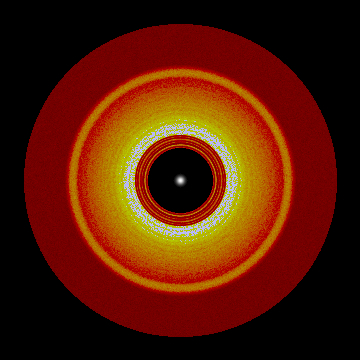Animations of Icy Planet Formation
Scott Kenyon (SAO) & Benjamin Bromley (Utah)
Overview
Each animation shows the brightness of dust grains in a planet-forming disk around a star.
With current technology, planets are too faint for direct observation. We need a surrogate to tell us where planets have recently formed.
When planets form, they stir up leftover planetesimals. These planetesimals collide at high velocity and fragment into smaller and smaller objects. This cascade of collisions produces copious amounts of dust.
When dust grains are abundant, they reflect an observable amount of radiation from the star at the center of the disk. Thus, this dust is a signpost of recent planet formation.
Making the Animations
From our calculations of planet formation, we derive the amount of dust in orbit around the star as a function of the distance from the star and the age of the star.
From the amount of dust, we derive the amount of starlight absorbed and reflected.
To make an image, we assign a brightness to each pixel in the image. This brightness is related to the amount of reflected starlight.
To make a movie, we string the images together. We usually have 500-1000 images per movie. Each image represents about 1-2 Myr in the life of the disk.
The animations require a player, such as Quicktime.
Animations
Three animations illustrate the evolution of bright rings of dust in a disk where icy planets form.
In our calculations, planets grow from collisions and mergers of smaller bodies - called planetesimals - embedded in a disk of gas and dust in orbit around a newly-formed star. Protoplanets with radii of 100 km or larger stir up the leftover planetesimals along their orbits. Collisions among the rapidly moving planetesimals produce rings of small dust grains, which scatter radiation from the central star. This dust slowly disappears as protoplanets grow into planets. Although planets and protoplanets are too faint for direct detection, the dust is observable. We calculate the formation of planets and dust using a multiannulus planet formation code and then derive the appearance of the dusty disk as a function of time.
The image above and to the left is the first frame of the first animation. The bright white dot is the star at the center of the disk. In this image, the star is 1000 times fainter than a real star.
A disk of planetesimals surrounds the star. The inner edge of the disk is at 30 AU (roughly the orbit of Neptune in our solar system); the outer edge is at 150 AU. Planetesimals in the disk reflect light from the star. Because the inner disk is denser and closer to the star, it is much brighter than the outer disk.
The clock in the lower right corner of each image indicates the length of the movie. The clock goes around once every billion years.
Each animation several phases
Each animation shows different aspects of planet formation.
SAO Home Page | CfA Home Page | Dept of Astronomy Home Page | Smithsonian Institution Home Page


